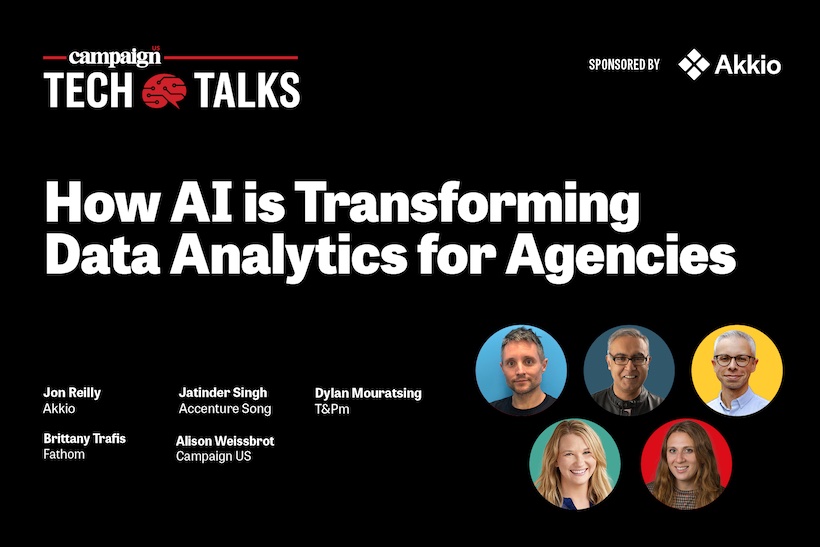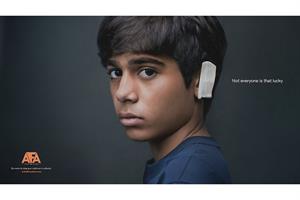As the buzz around AI somewhat settles, marketers are exploring its potential beyond content — and into the world of data analytics. Generative AI and natural language has huge implications for how marketers can analyze content and campaign performance and use that data to inform advertising. Companies can harness AI's power to win new pitches, predict future outcomes for campaign optimization, eliminate wasted resources from manual analysis and automatically surface key insights to stay ahead of the competition. That’s not to say that agencies won’t face challenges as they adopt AI and the technology becomes a more embedded part of their workforce.
During a recent Campaign US webinar, editor-in-chief Alison Weissbrot moderated a discussion between Dylan Mouratsing, chief data officer, T&Pm; Jon Reilly, cofounder and CEO, Akkio; Jatinder Singh, global head of data and AI, Accenture Song; and Brittany Trafis, EVP of AI innovation, Fathom, about the next frontier in AI-powered marketing.
Unlocking opportunities with AI
Enthusiasm for generative AI today centers around content, creative and copy; however, there is much opportunity for campaign analysis automation, optimization and reporting as well.
The advancement of AI technology allows agencies to pull insights more quickly. “Language models opened up all these capabilities that we didn't have before for interacting with data and getting answers to key questions,” Reilly explained.
AI is essential for getting insights through new data sources more quickly “We now have the ability to bring in all of the unstructured data and create synthetic datasets to get to insights that lead to a white space opportunity, ingesting all of the brand assets as well as ensure we stay on brand or legal guidelines,” Singh said.
In addition, AI eliminates some day-to-day grunt work. “Because we're spending less time building and we have so much more data available, we're spending more time in terms of optimizations, developing those insights— because something that could have taken three hours in the past now takes five minutes,” Trafis said.
Gen AI is freeing up time that can be “redeployed for more creative tasks, storytelling, human insights, innovative thinking, data partnerships, the things that are impossible for AI to do at this stage, that human persuasive element that we bring to the process,” Mouratsing added.
Embracing AI
Platforms can help agencies get results more quickly so they have time to think and execute better. “There's a broad range of adoption cases but they all point in the same direction: Take large amounts of data, answer questions efficiently, join that data the agency has with client first-party data, build custom models quickly and easily, and use those to make better decisions up and down the engagement stack,” Reilly explained.
AI can help drive that integration between data and creativity, and influence what creative assets are made. For example, “100% of the shoots or virtual production can be completely tuned to the audience data, the real world or even the simulation of outcomes that we can foresee based on the other parameters, such as the media budgets, channels, markets in question and category dynamics,” Mouratsing said.
Creatives can delve deeper into the work with insights. “Those insights ultimately feed a creative brief that is then going to enable us to build a brand, enhance performance marketing and fuel creativity at the brand equity level as well,” Singh said.
AI has also been useful in testing ads before they go to market. “We use AI to tell us and trend through all of that data to be able to identify what ad would perform best,” Trafis said. “We're able to test ad copy segmentation, a lot of the ad creative, so that way we can put those dollars to work faster to get to outcomes instead of the testing part.”
Driving optimization
AI is a huge performance driver, helping to not only draw insights from large amounts of data more quickly, but also predict insights. Predictive analytics can help brands have more effectively optimized campaigns in real time.
“Take a brand's data with converted customers. You can train a custom machine learning model to learn the patterns in the demographics or the behavioral data of the consumers and predict whether or not any given audience lead is going to convert or not,” Reilly explained.
After those insights are gleaned is “where that human element and empathy comes in,” Trafis said. “We're able to look at it and say ‘This is the strategy that we need moving forward, here's how we want to adjust our creative,’ or target it based on these insights.”
Predictive analytics can be used to assess creative performance before it goes live. “We can take what would have been considered underperforming or wasted media money and illustrate to clients quite vividly what the impact of that would have been if they doubled down on the upper quartiles of the performance creative,” Mouratsing explained.
In addition, predictive analytics is useful in evaluating paid media, promo media and trade dollars. “Generative AI is enabling us to create the connective tissue across those three different swim lanes,” Singh said. “We'll bring those insights together as a collective to optimize across that entire ecosystem.”
What’s next for AI
The AI landscape and suite of tools continues to evolve rapidly. It’s important for brands to experiment and evaluate how to use tools as they advance. Here are participants’ predictions for how AI will power data and analytics at agencies in the future:
“I see these models processing data even faster,” Trafis said. “We'll start to see more AI coming into play and having those mundane tasks automated for us so that we take all of the guesswork out of it and are able to make more informed real-time marketing decisions.”
The key takeaway is to “unlock value holistically to transformational change, which requires an organizational change, and whoever is ready to make that change is going to be the one that wins,” Singh said.
To Mouratsing, the focus will be “on getting that core data right at the center of every organization, having the data properly named, talking to each other, flowing efficiently, getting those foundations right, so everything else can then be built more robustly on top.”
Part of an organization’s real value is the “custom unique data that nobody else has that they can leverage to make better decisions,” Reilly concluded. “Making that data, having robust data, augmenting that data with the things that matter to learning the patterns about how people purchase and why they purchase will be incredibly important.”
To learn more about how AI can help transform brand analytics, visit Akkio.com.










